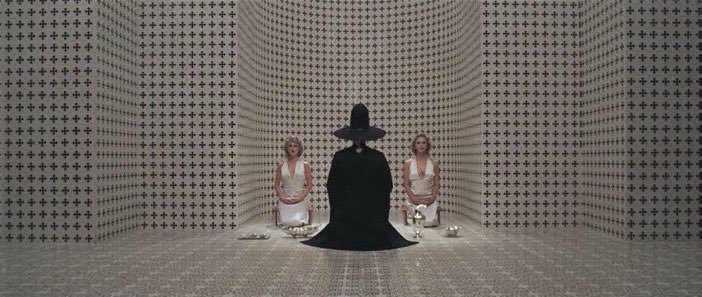Holy Mountain İsa benzeri bir karakterin, ruhani liderin dünyasına girip, gezegenleri temsil eden bir grupla tanışmasını konu alan bu etkileyici başyapıt, “anlatılmaz, yaşanır” türde bir filmdir. https://t.co/soxdetlC8z
Kaynak
The image shows a scene from a movie, likely a surreal or cult film. It depicts a room with walls covered in a repeating pattern of plus signs. In the center of the room, a person dressed in a long black robe and hat sits in a ritualistic pose. Two women in white sleeveless tops are seated on either side of the central figure. Small, round objects, possibly offering items, are placed on the floor in front of each person. The "joke" or the humorous aspect (which is more likely a commentary on societal norms and power dynamics in this scene) is not immediately obvious from the image itself. It depends on the context of the specific movie and any dialogue that may be present in that scene. It is likely a satire of religious or cultural practices, or a commentary on oppressive authority figures. It's not a "joke" in the sense of a punchline, but rather a visual pun or satire that is meant to be interpreted within the context of the story. In Turkish, the best way to describe this is with context. Without knowing the film, the most accurate description is something like: "Bir film sahnesi, muhtemelen sürrealist ya da kült bir filmden. Duvarları art arda + işaretleriyle kaplı bir odada, merkezi bir figür uzun bir siyah cübbe ve şapka giyerek ritüel bir pozisyonda oturuyor. Ortadaki figürün iki yanında, beyaz ince askılı üstler giyen iki kadın oturuyor. Her kişinin önünde, muhtemelen sunu olarak kullanılan küçük yuvarlak nesneler bulunuyor. Bu sahne, belki bir dinî ya da kültürel uygulamanın ironisini ya da baskıcı bir otorite figürünün yorumunu, filmin bağlamında ele alabiliriz." This translates to: "A scene from a movie, probably a surreal or cult film. In a room whose walls are covered in repeating plus signs, a central figure is seated in a ritualistic pose wearing a long black robe and hat. Two women in white sleeveless tops are seated on either side of the central figure. Small, round objects, possibly offerings, are placed on the floor in front of each person. This scene, based on the context of the movie, may address the irony of a religious or cultural practice or comment on oppressive authority figures."

Henüz bişi yazılmamış